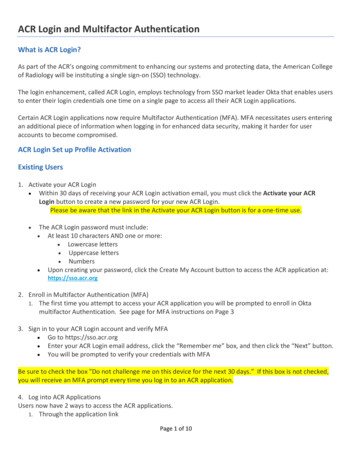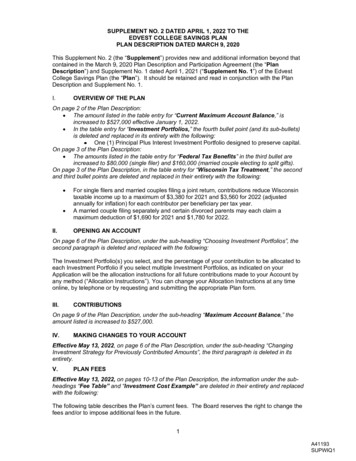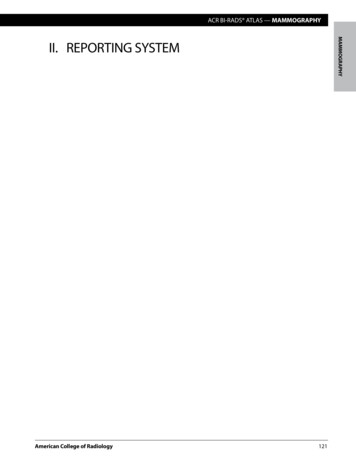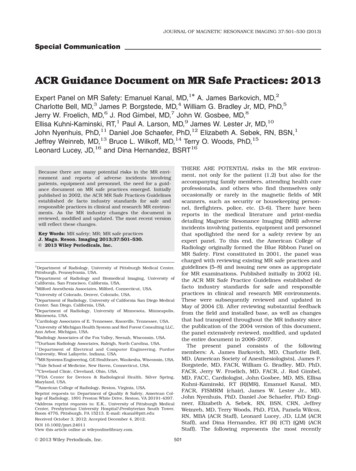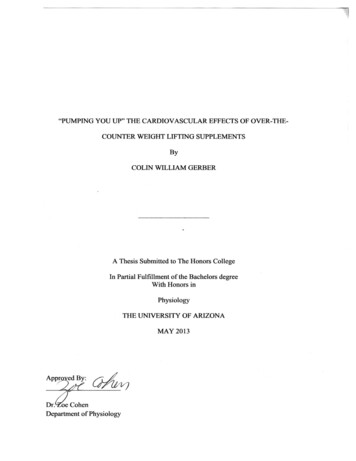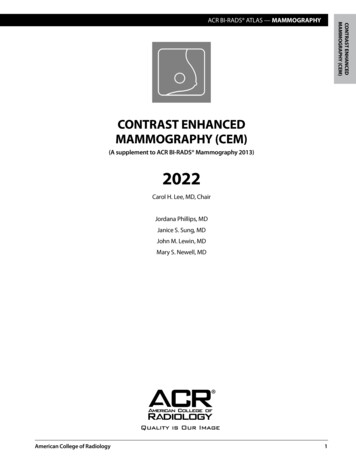
Transcription
CONTRAST ENHANCEDMAMMOGRAPHY (CEM)ACR BI-RADS ATLAS — MAMMOGRAPHYCONTRAST ENHANCEDMAMMOGRAPHY (CEM)(A supplement to ACR BI-RADS Mammography 2013)2022Carol H. Lee, MD, ChairJordana Phillips, MDJanice S. Sung, MDJohn M. Lewin, MDMary S. Newell, MDAmerican College of RadiologyRETURN TO TABLE OF CONTENTS1
CONTRAST ENHANCEDMAMMOGRAPHY (CEM)2022TABLE OF CONTENTSPREFACE . . . . . . . . . . . . . . . . . . . . . . . . . . . . . . . . . . . . . . . . . . . . . . . . . . . . . . . . . . . . . . 3INTRODUCTION . . . . . . . . . . . . . . . . . . . . . . . . . . . . . . . . . . . . . . . . . . . . . . . . . . . . . . . . . 4SECTION ORGANIZATION . . . . . . . . . . . . . . . . . . . . . . . . . . . . . . . . . . . . . . . . . . . . . . . . . . 5SECTION I: GENERAL CONSIDERATIONS . . . . . . . . . . . . . . . . . . . . . . . . . . . . . . . . . . . . . . . . . 6SECTION II: BREAST IMAGING LEXICON – CONTRAST ENHANCED DIGITAL MAMMOGRAPHY . . . . 8SECTION III: REPORT ORGANIZATION . . . . . . . . . . . . . . . . . . . . . . . . . . . . . . . . . . . . . . . . . .13SECTION IV: GUIDANCE . . . . . . . . . . . . . . . . . . . . . . . . . . . . . . . . . . . . . . . . . . . . . . . . . . . 21SECTION V: FAQ . . . . . . . . . . . . . . . . . . . . . . . . . . . . . . . . . . . . . . . . . . . . . . . . . . . . . . . . .27APPENDIX I: CLASSIFICATION FORM . . . . . . . . . . . . . . . . . . . . . . . . . . . . . . . . . . . . . . . . . . .30APPENDIX II: IMAGES . . . . . . . . . . . . . . . . . . . . . . . . . . . . . . . . . . . . . . . . . . . . . . . . . . . . .332RETURN TO TABLE OF CONTENTSAmerican College of Radiology
CONTRAST ENHANCEDMAMMOGRAPHY (CEM)ACR BI-RADS ATLAS — MAMMOGRAPHYPREFACEThe introduction of the American College of Radiology Breast Imaging Reporting and DataSystem (BI-RADS ) has revolutionized breast imaging interpretation and reporting and servesas the model for optimal reporting of radiologic studies.As the field of breast imaging has evolved to include newer technologies, so too has the BI-RADS atlas evolved. When first introduced in 1992, BI-RADS was little more than a pamphlet dealingonly with mammography. As experience with mammography grew and terms were validated byevidence, subsequent editions were released refining terms. The 4th edition of BI-RADS , which waspublished in 2003, included sections on ultrasound and magnetic resonance imaging (MRI) in addition to mammography. The 5th and current edition, released in December 2013, has continued torefine terms and expand on areas such as auditing and reporting.Contrast enhanced mammography (CEM) was first approved by the Food and Drug Administration(FDA) in 2011 and its use is increasing. CEM has been shown to be more sensitive than mammography or ultrasound for the detection of malignancy. Given that utilization is increasing, it is importantthat a lexicon be available to allow for consistency in reporting and also to allow for validation ofstandardized terms through studies looking at the performance of CEM in a variety of clinical settings. The next edition of BI-RADS is under development but rather than waiting to issue a sectionon CEM until the release of the new edition, this supplement is available to facilitate the interpretation and reporting of CEM studies.This is the first version of the BI-RADS lexicon for CEM and will undergo revisions and alterations asmore experience is gained with this modality and as studies to validate terms are performed. Untilthen, as with other sections of BI-RADS , we encourage consistent usage of the lexicon to promoteincreased clarity and precision in reporting and accuracy in reaching final assessments.Carol Lee, MD, FACRChair, Workgroup on BI-RADS CEM SupplementAmerican College of RadiologyRETURN TO TABLE OF CONTENTS3
CONTRAST ENHANCEDMAMMOGRAPHY (CEM)2022INTRODUCTIONTo perform CEM, intravenous iodinated contrast is administered and two exposures (low- andhigh-energy) are made using the standard mammography projections of craniocaudal (CC)and mediolateral oblique (MLO) with kVp settings that straddle the k-edge of iodine. The lowand high- energy images are then recombined and processed to indicate tissue that enhances withiodine. The low energy (LE) image serves as the standard digital mammogram and reporting for thisportion of the CEM examination should be no different than reporting for a standard mammogram.The mammography lexicon should be used for reporting the LE images. For the recombined (RC)image, the lexicon is similar but not identical to that used for MRI as outlined in this document.A significant finding on a CEM examination might be seen on the LE images only, on the RC images only, or on both. Therefore, separate descriptions of the LE and RC images as well as an overalldescription should be included.CEM is a relatively new technology and revisions to the lexicon will occur. If you would like to propose a substantive change, please submit it by e-mail (BI-RADS@acr.org) to the ACR for review bythe BI-RADS committee. However, please first visit the ACR BI-RADS web page ADS/BIRADSFAQ.pdf, which displays committeeapproved responses to suggestions already submitted.4RETURN TO TABLE OF CONTENTSAmerican College of Radiology
CONTRAST ENHANCEDMAMMOGRAPHY (CEM)ACR BI-RADS ATLAS — MAMMOGRAPHYSECTION ORGANIZATIONThe ACR BI-RADS – CEM is divided into four sections:SECTION I: General considerations and image acquisition parametersSECTION II: Breast Imaging Lexicon – CEMSECTION III: Reporting SystemSECTION IV: GuidanceAppendix I: ACR BI-RADS – CEM Lexicon Classification Form (for recombined images)Appendix II: ImagesThe following are brief summaries of each sectionI. General considerations and image acquisition parametersThe potential indications for the examination, workflow considerations, and acquisition parametersare discussed.II. Breast Imaging Lexicon – CEMThe lexicon for the LE image portion of the CEM is the same as the mammography lexicon. For theRC images, terms are adopted from the MRI section but modified to cover situations unique to CEM.Each descriptor is illustrated by images.III. Reporting SystemIn addition to the usual organization of the breast imaging report, the LE and the RC images shouldbe described separately, and the final assessment should be based on the most abnormal findingson each of these components.IV. GuidanceBecause CEM is a relatively new modality, many unanswered questions may arise in its performance.This section will discuss some questions that are commonly encountered in performing and interpreting these examinations.AppendixThe appendix contains a form for easily noting the findings on the RC images of a CEM examination with the appropriate BI-RADS terminology in a simple checklist. This form also contains theBI-RADS assessment categories. For findings on the LE images, whether or not they are seen on theRC images, please refer to the appendix in the BI-RADS mammography section.REFERENCES1.Lewin JM, Isaacs PK, Vance V, Larke FJ. Dual-energy contrast-enhanced digital subtractionmammography: feasibility. Radiology. 2003;229:261-268.2.Diekmann F, Diekmann S, Taupitz M, Bick U, Winzer KJ, Hüttner C, et al. Use of iodine-basedcontrast media in digital full-field mammography--initial experience. Rofo. 2003;175:342-345.American College of RadiologyRETURN TO TABLE OF CONTENTS5
CONTRAST ENHANCEDMAMMOGRAPHY (CEM)2022SECTION I: GENERAL CONSIDERATIONSGENERAL CONSIDERATIONSContrast enhanced mammography is referred to by several different names including contrast enhanced digital mammography and contrast enhanced spectral mammography. The preferred termwhich avoids overlap with proprietary names is contrast enhanced mammography (CEM).The post-processed combination of low-and high-energy images should be referred to as the recombined images (RC images).When starting to utilize this technique, it is prudent to decide for which indications and clinical settings the study will be used. There is some evidence that CEM may be useful for a variety of indications including determination of extent of disease in newly diagnosed breast cancer, response toneoadjuvant chemotherapy, problem solving, and intermediate and high-risk screening. CEM hasalso been proposed as an alternative to MRI when the patient is not a candidate for MRI.For any proposed indication, it is worthwhile to have a predetermined workflow for evaluationof (RC) imaging findings that have no correlate on conventional mammography or ultrasound.Although CEM–guided biopsy devices are FDA approved, these findings are commonly pursuedwith MRI and MRI biopsy as there is currently limited availability of CEM-guided biopsy. If MRI orMRI-guided biopsy is not available or cannot be tolerated by the patient, an alternative approachfor these findings will be needed and this should be recognized before CEM is performed. If neitherCEM-guided nor MRI-guided biopsy are available, possible options, depending on the level of suspicion of the finding could include short interval follow-up CEM, stereotactic biopsy using landmarks,or in rare circumstances image guided localization using landmarks followed by surgical excision.CEM requires the use of intravenous iodinated contrast and patients should be evaluated for risksfor contrast reaction. In addition, personnel at facilities that offer CEM should be fully trained andequipped to deal with contrast reactions. For patients who report prior contrast reactions, premedication can be considered to reduce the possibility of subsequent reaction. However, the dataon reducing severe reactions has not been consistently demonstrated. Overall, the potential benefitof performing CEM in these patients should be weighed against the possibility of a serious contrastreaction or side effects of the pre-medication.Many facilities choose to screen patients for impaired renal function or other relative contraindications to IV contrast. If this is elected by a facility, criteria for who should be screened prior tothe CEM examination should be the same as those used prior to CT studies that require contrast.Also, any screening to determine suitability for contrast administration should happen at the timeof scheduling so that lab work assessing renal function, if required, can be obtained before thepatient’s CEM visit. For patients with compromised renal function, the benefit of CEM should beweighed against the risk of contrast induced nephropathy prior to scheduling the exam. For a fulldiscussion of the use of intravenous contrast please refer to the ACR Manual on Contrast Mediaavailable on the ACR website anual).6RETURN TO TABLE OF CONTENTSAmerican College of Radiology
CONTRAST ENHANCEDMAMMOGRAPHY (CEM)ACR BI-RADS ATLAS — MAMMOGRAPHYWORKFLOW AND IMAGE ACQUISITION:There is little data that supports timing of CEM during any particular phase of the menstrual cycle.For MRI, the recommendation has been to schedule during week 2, but several studies have shownthat outcomes may not be affected by the stage of the menstrual cycle, and this may also be truefor CEM.Ready availability of personnel to start an intravenous line is critical to ensure timely performance ofthe study. To facilitate this, facilities should consider setting aside dedicated CEM time slots.The usual dose for CEM will depend on the patient’s body weight and the concentration of iodinein the agent used. Contrast is generally delivered with a power injector at a rate of 3 ml/sec. Aftera delay of approximately 2 minutes, the patient is positioned in the standard four mammographyprojections and two exposures are taken for each projection, one right after the other. The LE imageis obtained at a kVp in the range of standard mammography, generally 28 to 32 kVp, and the highenergy image typically between 45 and 49 kVp. A post-processed RC image is generated from theLE and high-energy images.The order of the projections obtained varies with the facility. In general, for a bilateral study, thesame view is alternated between the breasts so at least one view of each breast is obtained whilecontrast is maximally present. If there is one breast that requires particular attention, for examplea case of newly diagnosed breast cancer, both views of that breast can be obtained first. Also, if itis known that an additional non-standard view of one breast is needed, for example an exaggerated CC view, it can be obtained before imaging of the contralateral breast. The total time availableto obtain images before contrast washes out is between 7 to 10 minutes, so ideally the entire CEMshould performed within that time frame.REFERENCES1.Dromain C, Thibault F, Muller S, Rimareix F, Delaloge S, Tardivon A, et al. Dual-energy contrastenhanced digital mammography: initial clinical results. Eur Radiol. 2011:21; 565-74.2.Badr S, Laurent N, Régis C, Boulanger L, Lemaille S, Poncelet E. Dual-energy contrast-enhanceddigital mammography in routine clinical practice in 2013. Diagn Interv Imaging. 2014:95;24558.3.Sognani J, Mango VL, Keating D, Sung JS, Jochelson MS. Contrast-enhanced mammography:past, present, and future. Clin Imaging 2021: 69; 269–279.4.Ghaderi KF, Phillips J, Perry H, Lotfi P, Mehta TS. Contrast-enhanced mammography: Applications and future directions. RadioGraphics 2019; 39:1907–1920.5.Polat DS, Evans WP, Dogan BE. Contrast-enhanced digital mammography: Technique, clinicalapplications, and pitfalls. AJR 2020; 215:1267–1278.6.Sumkin JH, Berg WA, Carter GJ, Bandos AI, Chough DM, Ganott MA, Hakim CM, Kelly AE, ZuleyML, Houshmand G, Anello MI, Gur D. Diagnostic Performance of MRI, Molecular Breast Imaging, and Contrast-enhanced Mammography in Women with Newly Diagnosed Breast Cancer.Radiology. 2019:293; 531-540.7.Covington MF. Contrast-enhanced mammography implementation, performance, and use forsupplemental breast cancer screening. Radiol Clin N Am 2021: 59; 113–128.American College of RadiologyRETURN TO TABLE OF CONTENTS7
CONTRAST ENHANCEDMAMMOGRAPHY (CEM)2022SECTION II:BREAST IMAGING LEXICON - CONTRASTENHANCED DIGITAL MAMMOGRAPHYTable 1: CEM Lexicon OverviewBreast TissueTermsA. Breast Compositiona.b.c.d.Almost entirely fattyScattered areas of fibroglandular densityHeterogeneously denseExtremely denseB. Background parenchymal enhancement(BPE)1. Levela.b.c.d.2. Symmetric orAsymmetrica. Symmetricb. AsymmetricMinimalMildModerateMarkedFINDINGS ON LOW ENERGY IMAGES ONLY: Refer to mammography BI-RADS lexiconFINDINGS ON RECOMBINED IMAGES ONLY:FindingA. Mass8RETURN TO TABLE OF CONTENTSTerms1. Shapea. Ovalb. Roundc. Irregular2. Marginsa. Circumscribedb. Not circumscribedi. Irregularii. Spiculated3. Internal EnhancementCharacteristicsa. Homogeneousb. Heterogeneousc. Rim enhancementAmerican College of Radiology
B. Non-mass Enhancement (NME)1.Distributiona.b.c.d.e.f.2.Internal EnhancementPatterna. Homogeneousb. Heterogeneousc. ClumpedC. Enhancing AsymmetryInternal EnhancementPatternD. Lesion Conspicuitya.b.c.CONTRAST ENHANCEDMAMMOGRAPHY (CEM)ACR BI-RADS ATLAS — MAMMOGRAPHYDiffuseMultiple regionsRegionalFocalLinearSegmentala. Homogeneousb. HeterogeneousLowModerateHighFINDINGS ON LOW ENERGY IMAGES WITH ASSOCIATED ENHANCEMENT ON RECOMBINED IMAGES:MorphologyRefer to mammography lexiconInternal Enhancement Patterna. Homogeneousb. Heterogeneousc. RimExtent of Enhancementa. Mammographic lesion partially enhancesb. Mammography lesion completely enhancesc. Enhancement extends beyond mammographiclesiond. No enhancement of the mammographic lesion butenhancement in the adjacent tissueLesion Conspicuitya. Lowb. Moderatec. HighASSOCIATED FEATURES:Associated FeaturesAmerican College of Radiologya.b.c.d.e.f.Nipple retractionNipple invasionSkin retractionSkin thickeningSkin invasionAxillary adenopathyRETURN TO TABLE OF CONTENTS9
CONTRAST ENHANCEDMAMMOGRAPHY (CEM)20221.Breast composition: Breast composition should be assessed on the low energy images andcharacterized using categories similar to conventional mammography. The report shouldinclude a description of the breast composition using one of the following terms:a. Almost entirely fattyb. Scattered areas of fibroglandular densityc. Heterogeneously densed. Extremely dense2.Background Parenchymal Enhancement (BPE): The presence of background parenchymalenhancement of the normal breast tissue should be described. As CEM is performed withintravenous contrast, fibroglandular breast parenchyma may demonstrate normal enhancement. BPE is not necessarily directly related to the amount of fibroglandular tissue and shouldbe described as:a. Minimalb. Mildc. Moderated. MarkedAs is the case with MRI, BPE should be described relative to the amount of the fibroglandulartissue and not the entire volume of the breast.e.Symmetric vs Asymmetric:i.Symmetric BPE denotes similar levels and distribution of BPE between the twobreasts.ii. Asymmetric BPE denotes a greater level of more broad distribution of enhancementin one breast than in the other. This may be seen after radiation therapy, with theradiated breast showing less BPE. If asymmetric BPE is seen without a known cause, itshould be evaluated as it may represent a pathologic process such as diffuse inflammation or diffuse malignancy in the breast with the asymmetrically higher BPE.3.Findings seen on CEM are divided into three broad categories: Those seen on the LE images only, those presenting as areas of enhancement only seen on the RC images, and thoseseen on the LE images with associated enhancement on the RC images. It should be clearlystated in the report whether a finding is seen on the low energy images only, on the recombined images only, or on both. If there are separate findings on the LE and RC images, thisshould be clearly stated.a. Finding on low energy images only: A finding apparent on the low-energy images onlyshould be described using the BI-RADS mammography lexicon. For example, masses thatdemonstrate no enhancement may be described by their shape, margin, and density. Calcifications should be described as benign or if not classically benign, by their morphology anddistribution.10 RETURN TO TABLE OF CONTENTSAmerican College of Radiology
b. Enhancement on RC images only: A finding visualized only on the RC images may bedescribed as a mass, non-mass enhancement, or an enhancing asymmetry. The descriptorsfor areas of enhancement on CEM are in general the same as those used for MRI. However, theCEM lexicon includes fewer descriptors than the MRI lexicon due to the lower resolution ofCEM. In addition, unlike MRI, there are cases in which abnormal enhancement is seen on oneview only. This should be called an “enhancing asymmetry.” The conspicuity of the lesion, reflecting the degree of enhancement relative to background parenchymal enhancement mayalso be described.i.Mass: A mass is a 3-D space occupying lesion with a convex-outward contour. Theremay or may not be an identifiable correlate on the low energy images. If there is noLE correlate, the mass shape/margin and internal pattern of enhancement should becharacterized on the recombined images.1. Shape/margin: Descriptors for mass shape and margin are the same as for MRI,and include oval, round, or irregular shape, with circumscribed or not circumscribed (irregular, spiculated) margin.2. Internal pattern of enhancement: A mass may demonstrate homogeneous, heterogeneous, or rim enhancement.ii. Non-mass enhancement (NME): Enhancement that is neither a mass nor an enhancing asymmetry is classified as non-mass enhancement. NME should be classified according to its distribution and described as focal, linear, segmental, regional, multipleregions, or diffuse. However, unlike with MRI, the internal enhancement pattern ofNME may not be clearly discernible due to the lower resolution of CEM comparedto MRI. If visible, internal enhancement pattern may be described as homogeneous,heterogeneous, or clumped.iii. Enhancing asymmetry: This term should be used for a finding seen on only one viewon the RC images. If desired, the internal enhancement pattern of an asymmetry canbe described as homogeneous or heterogeneous. If a one-view asymmetry is seenon the LE image and exhibits enhancement, it can also be described as an enhancingasymmetry.iv. Lesion conspicuity (relative to background): Degree of enhancement relative to background may be described as low, moderate, or high. These are subjective qualitativedescriptors relative to the degree of background parenchymal enhancement. Lowrefers to enhancement equal to or slightly greater than BPE, high if the enhancementis much greater than BPE, and moderate if the enhancement is in between low andhigh. For CEM, there is no data yet to correlate lesion conspicuity with likelihoodof malignancy. Terms for conspicuity are included in the lexicon to allow for futureresearch.c. Findings seen on low-energy images with associated enhancement on recombinedimages: for enhancing lesions with a correlate on LE images (mass asymmetry, focal asymmetry, architectural distortion, or calcifications); the LE finding should be described using theBI-RADS mammography lexicon. If the LE finding that enhances is not a mass (asymmetry,American College of RadiologyRETURN TO TABLE OF CONTENTS 11CONTRAST ENHANCEDMAMMOGRAPHY (CEM)ACR BI-RADS ATLAS — MAMMOGRAPHY
CONTRAST ENHANCEDMAMMOGRAPHY (CEM)2022architectural distortion, or calcifications) and the area enhances, the characteristics of theenhancement should be described using the CEM lexicon. For masses seen on the LE imagesthat also enhance, it is not always necessary to further describe the mass shape and margin asseen on the RC images. Other descriptors besides shape and margin for enhancement seenon RC images include:i.Internal pattern of enhancement: homogeneous, heterogeneous, rim.ii. Extent of enhancement1. The mammographic lesion partially enhances2. The mammographic lesion completely enhances3. The enhancement extends beyond the mammographic lesion4. There is no enhancement of the mammographic lesion but there is surroundingenhancement in the tissue adjacent to the lesion. This commonly occurs withinflamed cysts or fat necrosis.iii. Lesion conspicuity: Low, moderate, or high as described in section 3.b.iv.4.Associated Features: These are generally seen on the LE images and can also sometimes beappreciated on the RC images.a. Nipple retraction: Nipple retraction is when the nipple is pulled in. New nipple retractionis associated with increased suspicion of underlying.b. Nipple invasion: Tumor is contiguous and invades the nipple.c. Skin retraction: Skin is pulled in abnormally.d. Skin thickening: Skin thickening is defined as being greater than 2-3 mm in thickness. Skinthickening without enhancement may represent post treatment related changes (such assurgery and/or radiation) or a systemic process if bilateral and diffuse. However, diffuseskin thickening, with or without areas of enhancement, may also be secondary to lymphatic obstruction from malignancy or locally advanced breast cancer.e. Skin invasion: Skin invasion may be seen with direct tumor invasion or with inflammatorycancer.f.Trabecular thickeningg. Axillary adenopathy: Enlarged axillary lymph nodes may warrant comment, clinical correlation and additional evaluation, especially if they are new or considerably larger orrounder when compared to prior studies.5.Lesion location: The location of a suspicious lesion should be described using standardclock-face clinical orientation. Similar to mammography, the side is given first, followed by thequadrant, clock-face location, and the depth of the lesion (anterior, middle, or posterior third).12 RETURN TO TABLE OF CONTENTSAmerican College of Radiology
SECTION III: REPORT ORGANIZATIONThe reporting system should be concise and organized and include any pertinent clinical historythat may affect interpretation of the examination. The report should include a description of theamount of fibroglandular tissue and the degree of background parenchymal enhancement (BPE).Significant findings on the LE and on the RC images should be described and an assessment rendered based on the most suspicious finding. For any given finding, it is important to state clearlywhether it is seen on the LE images only, the RC images only, or both.Report Structure1. Indication for examination2. CEM technique3. Comparison to previous examination(s)4. Succinct description of overall breast composition5. Clear description of any important findings6. Assessment7. Management1.INDICATION FOR EXAMINATIONThe indication for examination should contain a concise description of the patient’s clinicalhistory, including:a. Reason for performing the exam (e.g., screening, staging, problem solving)b. Clinical abnormalities, if any including laterality and duration2.CEM TECHNIQUEGive a brief description of the protocol.a. Laterality (right, left, bilateral) and views.b. Name of contrast agentc. Dosage (mmol/kg) and volume (in cc)d. Presence or absence of complications/contrast reaction; if there is a reaction, include adescription of the reaction, management and disposition of the patient. Contrast reactions and recommendations for further management should also be detailed in the finalrecommendation section to be certain it is noted by the referring clinician.American College of RadiologyRETURN TO TABLE OF CONTENTS 13CONTRAST ENHANCEDMAMMOGRAPHY (CEM)ACR BI-RADS ATLAS — MAMMOGRAPHY
CONTRAST ENHANCEDMAMMOGRAPHY (CEM)20223.COMPARISON TO PREVIOUS EXAMINATION(S)Include a statement indicating that the current examination has been compared to previousstudies including the type of exam [CEM, digital mammogram, etc. with specific date(s)]. If noprior exams are available for comparison this should be stated. Correlation with other breastimaging such as ultrasound, MRI should be reported if performed. The status of any findingthat is reported should be detailed, whether stable, increased, decreased, or new.4.SUCCINCT DESCRIPTION OF OVERALL BREAST COMPOSITIONThis should include an overall description of the breast composition as determined by the LEimages.Breast Composition Categoriesa. Almost entirely fattyb. Scattered areas of fibroglandular tissuec. Heterogeneously densed. Extremely denseThe amount of background parenchymal enhancement on the recombined imagesa. Minimalb. Mildc. Moderated. MarkedOn bilateral examinations, describe whether the pattern is asymmetric or symmetric, if appropriate.If an implant is present, it should be so stated in the report. Note that CEM has not been studied in patients with implants and like standard mammography is not accurate for assessmentof silicone implant integrity.5.CLEAR DESCRIPTION OF ANY IMPORTANT FINDINGSSignificant findings on the LE and RC images should be reported and correlated. If there isan abnormality on the LE images, a statement as to whether it is seen on the RC images andvice versa should be included. When there is a finding on the LE images, descriptors using themammography lexicon should be used. When there is a finding on the RC images descriptorsas outlined in the CEM lexicon section should be used. If the finding is present on both the LEand RC images, descriptors of both using the lexicon should be reportedAbnormal enhancement is unique and separate from BPE. Its description should indicate thebreast in which the abnormal enhancement occurs, the lesion type, and modifiers.14 RETURN TO TABLE OF CONTENTSAmerican College of Radiology
The report of any significant finding should include:a. Sizeb. Locationi.Right, left, or bilateralii. Breast quadrant and clock-face position (or central, retroareolar, and axillary taildescriptors)iii. Depth (anterior, mid, or posterior)c. Descriptors for abnormal enhancement. If a mass is seen on both the LE and RC images,the shape and margin should be described using the mammography lexicon. Repeatingthe descriptors for the findings on the RC image is not necessary.i.Mass shape (if seen on RC image only) margin if evaluable (if seen on RC image only) internal characteristics, if evaluable lesion conspicuityii. Non-mass distribution internal characteristics, if evaluable lesion conspicuityiii. Enhancing asymmetry lesion conspicuityd. Artifacts if severe enough to potentially affect interpretation6.ASSESSMENTAll reports should include an assessment category. This should reflect the most abnormalfinding whether on LE images, RC images, both, or neither.ASSESSMENT CATEGORIESCategory 0: Incomplete — Need Additional Imaging Evaluation and/or prior mammograms forcomparisonThis category is used when there is a finding for which additional imaging evaluation is needed.Category 0 can be used if additional mammographic views, ultrasound, or MRI are desired to makea final assessment. However, the use of category 0 for CEM is discouraged, particularly if the finding is seen on the LE images, unless the examination is read off-line, and the patient needs to beAmerican College of RadiologyRETURN TO TABLE OF CONTENTS 15CONTRAST ENHANCEDMAMMOGRAPHY (CEM)ACR BI-RADS ATLAS — MAMMOGRAPHY
CONTRAST ENHANCEDMAMMOGRAPHY (CEM)2022recalled for the additional imaging. For these cases, the CEM is analogous to a screening mammogram and the use of BI-RADS 0 is appropriate.Additionally, unlike MRI, where most of the information needed to make a final assessment isincluded in the standard protocol for the exam, this is not necessarily true for
ACR BI-RADS ATLAS MAMMOGRAPHY American College of Radiology RETURN TO TABLE OF CONTENTS 1 CONTRAST ENANCED MAMMOGRAP (CEM) CONTRAST ENHANCED MAMMOGRAPHY (CEM) (A supplement to ACR BI-RADS Mammography 2013) 2022 Carol H. Lee, MD, Chair Jordana Phillips, MD Janice S. Sung, MD John M. Lewin, MD Mary S. Newell, MD
